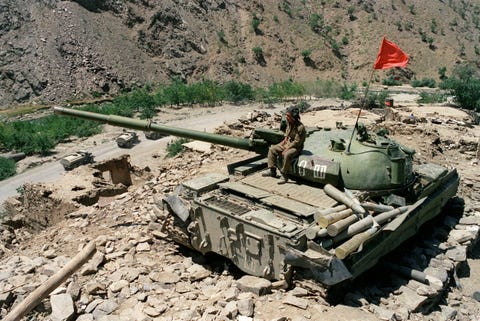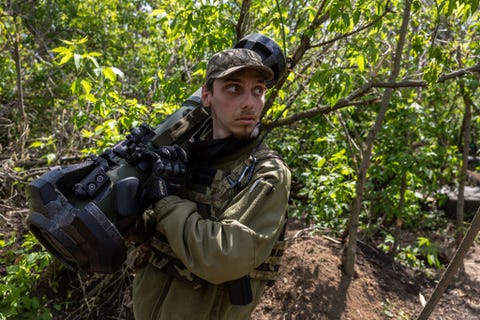KYLE MIZOKAMI

The Russian Army has begun deployment of one of the oldest tanks in its stockpile, the T-62 main battle tank. The T-62, which the Soviet Union produced between 1962 and 1973, is poorly armored by modern standards, with little of the protection that modern vehicles offer. Relying on these tanks will only exacerbate Russia’s losses in its ongoing invasion of Ukraine—both in hardware and in human lives.
In just over 100 days, the Russian Army has lost an estimated 15,000 personnel, killed in action. Russian equipment losses have been especially heavy, as well, with at least 761 tanks, 840 infantry fighting vehicles, 271 artillery pieces, 30 fixed-wing aircraft, and an entire guided-missile cruiser destroyed. Much of Russia’s war machine has proved hollow, with numerous cases of substandard or crudely-maintained equipment, poorly-trained soldiers, and overall lousy morale.
Both in the field and in deep storage, the Russian Army has approximately 12,420 tanks, according to Global Firepower, a website that maintains rankings of global military strength. Russia has built comparatively few tanks since the end of the Cold War, relying on thousands of T-72 and T-80 main battle tanks that the Soviet Union produced between the late 1970s and 1991, when the USSR broke up. Decades old, Russia has renovated and upgraded these tanks into improved versions, including the T-72B1, T-72B3, and T-80BVM. Although enhanced, they still suffer from 50-year-old design decisions that make them more vulnerable to catastrophic destruction.

A Russian T-62 crosses the empty highway linking Tbilisi and western Georgia on August 21, 2008 at a checkpoint manned by the Russian forces.
The T-62 is a second-generation main battle tank. The Soviet Union produced it to replace the older T-55 tank; it first deployed the T-62 in large numbers with the Group of Soviet Forces in Germany in 1963. The T-62 was equipped with a U-5TS 115-millimeter main gun and a 7.62-millimeter PK-T machine gun mounted coaxially. The tank had 230-millimeter frontal-turret armor and 100-millimeter frontal-hull armor, making it heavily armored for its time. Unlike later tanks, a humans had to manually load the gun, giving it a total crew of four.

An Afghan soldier sitting on top of a T-62M tank near the Salang Pass, August 1989. Note the laser rangefinder mounted at the base of the main gun and the additional armor, with white markings, wrapped around the front of the turret.
GEORGES GOBETGETTY IMAGES
In the early 1980s, baseline T-62s were upgraded into the T-62M and -MV standard. The tanks featured NII Stali BDD appliqué armor designed to boost the tank’s chances of survival on the battlefield, increasing frontal-turret protection from 230-millimeter to 450-millimeter against shaped-charge warheads used by anti-tank missiles. The tanks also received ballistic computers, laser rangefinders, and an improved gunner’s sight and gun stabilization systems. Tanks upgraded to the -MV standard received reactive armor consisting of explosive boxes meant to counteract the effects of a shaped-charge attack.
Unfortunately, as impressive as this sounds, none of it is particularly useful in Ukraine. The 450-millimeter armor protection was an acceptable standard in 1982, but in 2022, many tanks feature 900-millimeter protection or more. Modern anti-tank weapons provided to Ukraine, particularly NLAW and Javelin, fire their warhead downward through a tank turret roof.
The T-62 still has just 30 millimeters of turret-roof armor, as much as it did in 1965, leaving it critically vulnerable to modern weapons. T-62s sighted in Ukraine have grid cages installed on the turret roof. The cages, derisively nicknamed “cope cages,” are supposed to provide additional protection against shaped-charge attacks. Unfortunately, there are numerous examples of even newer tanks equipped with the cages destroyed on the battlefield, strongly suggesting they don’t work as intended.
There are other problems with the T-62s. As we’ve seen with the rest of Russia’s vehicle fleet, many tanks and armored vehicles—even relatively new ones—have been poorly maintained and suffer from reliability problems in Ukraine. Any T-62 pressed into service is at least 40 years old, suffering from decades of neglect. Unlike newer tanks, the T-62 has a crew of four, increasing manpower demands on an already manpower-strapped force. And if the tank is destroyed, total destruction of the T-62 results in the loss of four tankers, not three.

The T-62 tank is so old that the anti-tank weapons facing it were developed long after it was considered obsolete. There is no comparable tank like it left today in the West; it would be unethical to force soldiers to fight in a tank as obsolete as the T-62. Yet to all of this, there is a silver, morbid, lining: if deploying T-62s to Ukraine accelerates Russian army losses, it could hasten an end to the war.
No comments:
Post a Comment